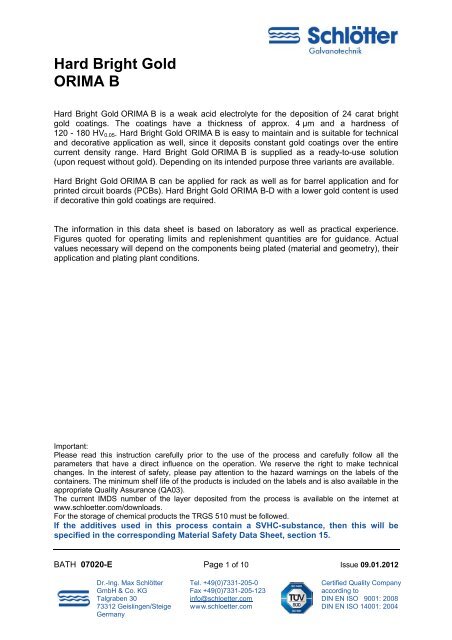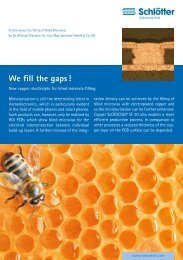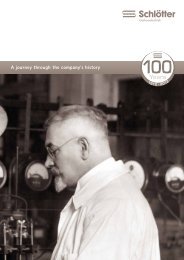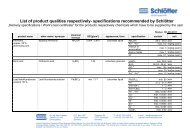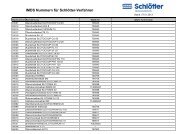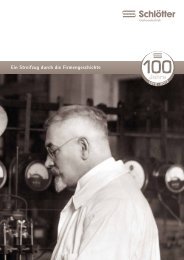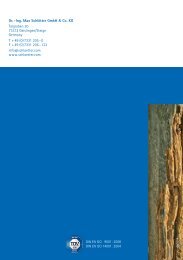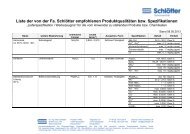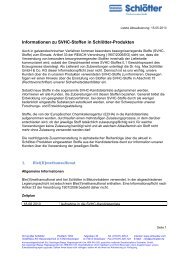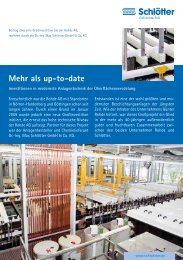Hard Bright Gold ORIMA B - Schloetter.de
Hard Bright Gold ORIMA B - Schloetter.de
Hard Bright Gold ORIMA B - Schloetter.de
Create successful ePaper yourself
Turn your PDF publications into a flip-book with our unique Google optimized e-Paper software.
<strong>Hard</strong> <strong>Bright</strong> <strong>Gold</strong><strong>ORIMA</strong> B<strong>Hard</strong> <strong>Bright</strong> <strong>Gold</strong> <strong>ORIMA</strong> B is a weak acid electrolyte for the <strong>de</strong>position of 24 carat brightgold coatings. The coatings have a thickness of approx. 4 µm and a hardness of120 - 180 HV 0.05 . <strong>Hard</strong> <strong>Bright</strong> <strong>Gold</strong> <strong>ORIMA</strong> B is easy to maintain and is suitable for technicaland <strong>de</strong>corative application as well, since it <strong>de</strong>posits constant gold coatings over the entirecurrent <strong>de</strong>nsity range. <strong>Hard</strong> <strong>Bright</strong> <strong>Gold</strong> <strong>ORIMA</strong> B is supplied as a ready-to-use solution(upon request without gold). Depending on its inten<strong>de</strong>d purpose three variants are available.<strong>Hard</strong> <strong>Bright</strong> <strong>Gold</strong> <strong>ORIMA</strong> B can be applied for rack as well as for barrel application and forprinted circuit boards (PCBs). <strong>Hard</strong> <strong>Bright</strong> <strong>Gold</strong> <strong>ORIMA</strong> B-D with a lower gold content is usedif <strong>de</strong>corative thin gold coatings are required.The information in this data sheet is based on laboratory as well as practical experience.Figures quoted for operating limits and replenishment quantities are for guidance. Actualvalues necessary will <strong>de</strong>pend on the components being plated (material and geometry), theirapplication and plating plant conditions.Important:Please read this instruction carefully prior to the use of the process and carefully follow all theparameters that have a direct influence on the operation. We reserve the right to make technicalchanges. In the interest of safety, please pay attention to the hazard warnings on the labels of thecontainers. The minimum shelf life of the products is inclu<strong>de</strong>d on the labels and is also available in theappropriate Quality Assurance (QA03).The current IMDS number of the layer <strong>de</strong>posited from the process is available on the internet atwww.schloetter.com/downloads.For the storage of chemical products the TRGS 510 must be followed.If the additives used in this process contain a SVHC-substance, then this will bespecified in the corresponding Material Safety Data Sheet, section 15.BATH 07020-E Page 1 of 10 Issue 09.01.2012Dr.-Ing. Max SchlötterGmbH & Co. KGTalgraben 3073312 Geislingen/SteigeGermanyTel. +49(0)7331-205-0Fax +49(0)7331-205-123info@schloetter.comw w w.schloetter.comCertified Quality Companyaccording toDIN EN ISO 9001: 2008DIN EN ISO 14001: 2004
1.0 TECHNICAL INFORMATION AND EQUIPMENT REQUIREMENTSTank:Local/Exhaust Ventilation:Part/Electrolyte agitation:Filtration:Ano<strong>de</strong>s:Heating/Cooling:polypropylene, PVC or other qualified plastics, tanks ma<strong>de</strong>of glass are also suitablerecommen<strong>de</strong>da) usual parts:parallel to the ano<strong>de</strong>s at a rate of 1.5 - 2.5 m/min;stroke length approx. 50 - 80 mm;Variant D requires additional air agitation with oil-free airb) PCBs:from and to the ano<strong>de</strong>s at a rate of 0.5 - 0.8 m/min;stroke length approx. 30 mmin larger plants continuous filtration with 1 - 2 turnovers perhourplatinized titaniumporcelain or PTFE coated immersion heaters2.0 MAKE-UP AND OPERATING CONDITIONS2.1 Product names2.1.1 Technical applicationList of products required for <strong>Hard</strong> <strong>Bright</strong> <strong>Gold</strong> <strong>ORIMA</strong> B-Static electrolyteProduct name Article no. (AN) SG<strong>ORIMA</strong> B-Static electrolyte with 8.5 g/l gold 071001 1.11<strong>ORIMA</strong> B-Static electrolyte without gold 071000 1.11<strong>ORIMA</strong> B Agent 070002 --<strong>Bright</strong>ener <strong>ORIMA</strong> B 070001 1.12<strong>Gold</strong> Bath Additive G (see point 4.5) 070701 0.79Orthophosphoric acid, (85 %) p.a.supplied by user* 1.71(see point 2.2 and 4.3)Potassium hydroxi<strong>de</strong> p.a. (see point 4.3) supplied by user* --Activated Carbon; our service <strong>de</strong>partment andfield service will be pleased to provi<strong>de</strong> you with<strong>de</strong>tailed information on suitable activatedcarbon and carbon filter cartridges.(see point 3.1 and 4.5)-- --* Product quality specifications recommen<strong>de</strong>d by us can be found on the internet atwww.schloetter.com/downloads.BATH 07020-E Page 2 of 10 Issue 09.01.2012Dr.-Ing. Max SchlötterGmbH & Co. KGTalgraben 3073312 Geislingen/SteigeGermanyTel. +49(0)7331-205-0Fax +49(0)7331-205-123info@schloetter.comw w w.schloetter.comCertified Quality Companyaccording toDIN EN ISO 9001: 2008DIN EN ISO 14001: 2004
2.1.2 Barrel platingList of products required for <strong>Hard</strong> <strong>Bright</strong> <strong>Gold</strong> <strong>ORIMA</strong> B-Barrel applicationProduct name Article no. (AN) SG<strong>ORIMA</strong> B-Barrel electrolyte with 4.25 g/l gold 071101 1.11<strong>ORIMA</strong> B Agent 070002 --<strong>Bright</strong>ener <strong>ORIMA</strong> B 070001 1.12<strong>Gold</strong> Bath Additive G (see point 4.5) 070701 0.79Orthophosphoric acid, (85 %) p.a.supplied by user* 1.71(see point 2.2 and 4.3)Potassium hydroxi<strong>de</strong> p.a. (see point 4.3) supplied by user* --Activated Carbon; our service <strong>de</strong>partment andfield service will be pleased to provi<strong>de</strong> you with<strong>de</strong>tailed information on suitable activatedcarbon and carbon filter cartridges.(see point 3.1 and 4.5)-- --* Product quality specifications recommen<strong>de</strong>d by us can be found on the internet atwww.schloetter.com/downloads.2.1.3 Decorative gold-platingList of products required for <strong>Hard</strong> <strong>Bright</strong> <strong>Gold</strong> <strong>ORIMA</strong> B-DProduct name Article no. (AN) SG<strong>ORIMA</strong> B-D with 1.7 g/l gold 071201 1.08<strong>ORIMA</strong> B-D without gold 071200 1.08<strong>ORIMA</strong> B Agent 070002 --<strong>Bright</strong>ener <strong>ORIMA</strong> B 070001 1.12<strong>Gold</strong> Bath Additive G (see point 4.5) 070701 0.79Orthophosphoric acid, (85 %) p.a.supplied by user* 1.71(see point 2.2 and 4.3)Potassium hydroxi<strong>de</strong> p.a. (see point 4.3) supplied by user* --Activated Carbon; our service <strong>de</strong>partment andfield service will be pleased to provi<strong>de</strong> you with<strong>de</strong>tailed information on suitable activatedcarbon and carbon filter cartridges.(see point 3.1 and 4.5)-- --* Product quality specifications recommen<strong>de</strong>d by us can be found on the internet atwww.schloetter.com/downloads.2.2 Requirements for a 100 litre bathThree different variants are available according to the respective purpose. All three versionsare <strong>de</strong>livered as ready-to-use solutions.BATH 07020-E Page 3 of 10 Issue 09.01.2012Dr.-Ing. Max SchlötterGmbH & Co. KGTalgraben 3073312 Geislingen/SteigeGermanyTel. +49(0)7331-205-0Fax +49(0)7331-205-123info@schloetter.comw w w.schloetter.comCertified Quality Companyaccording toDIN EN ISO 9001: 2008DIN EN ISO 14001: 2004
2.3 Make-up sequence for a 100 litre bathOn special request the electrolytes are <strong>de</strong>livered without gold. <strong>Gold</strong> Potassium Cyani<strong>de</strong> mustbe ad<strong>de</strong>d according to the following table:ElectrolyteAddition<strong>ORIMA</strong> B-Static electrolyte 12.5 g/l <strong>Gold</strong> Potassium Cyani<strong>de</strong>, (68.2 %)<strong>ORIMA</strong> B-D 2.5 g/l <strong>Gold</strong> Potassium Cyani<strong>de</strong>, (68.2 %)Please note, that all tanks and equipment to be used should be thoroughly cleaned prior touse. New unused tanks, filtration equipment etc. or tanks and equipment that have beenused with other electrolytes, should be leached out for 24 hours with 1-vol.% phosphoric acidat approx. 35 °C before use.2.4 Concentrations and operating conditions2.4.1 Static electrolyte (technical application)Range Optimum<strong>Gold</strong> content -- 8.5 g/lElectrolyte <strong>de</strong>nsity 1.08 - 1.20 -- g/cm³Operating temperature 25 - 40 32 °CCathodic current <strong>de</strong>nsity 0.6 - 2 1.1 A/dm²Anodic current <strong>de</strong>nsity max. 1 A/dm²pH range 3.9 - 4.5 4.2Plating rate(at 1.0 A/dm² and 32 °C)approx. 0.25µm/min.<strong>Hard</strong>ness 120 - 180 HV 0.05 kp/mm²The gold coating contains:> 99.5 % Au< 0.5 % CoElectrical resistivity of the gold <strong>de</strong>posit:at 0 °C 4.9 µΩ/cmat 50 °C 5.6 µΩ/cmBATH 07020-E Page 4 of 10 Issue 09.01.2012Dr.-Ing. Max SchlötterGmbH & Co. KGTalgraben 3073312 Geislingen/SteigeGermanyTel. +49(0)7331-205-0Fax +49(0)7331-205-123info@schloetter.comw w w.schloetter.comCertified Quality Companyaccording toDIN EN ISO 9001: 2008DIN EN ISO 14001: 2004
2.4.2 Barrel electrolyte (barrel plating)Range Optimum<strong>Gold</strong> content -- 4.25 g/lElectrolyte <strong>de</strong>nsity 1.08 - 1.20 -- g/cm³Operating temperature 25 - 40 32 °CCathodic current <strong>de</strong>nsity 0.2 - 0.5 0.4 A/dm²Anodic current <strong>de</strong>nsity max. 1 A/dm²pH range 3.9 - 4.5 4.2Plating rate (at 0.4 A/dm² and 32 °C) 0.05 µm/min.<strong>Hard</strong>ness 120 - 180 HV 0.05 kp/mm²The gold coating contains:> 99.5 % Au< 0.5 % CoSpecific electrical resistivity of thegold <strong>de</strong>posit:at 0 °C 4.9 µΩ/cmat 50 °C 5.6 µΩ/cm2.4.3 Variant D (<strong>de</strong>corative gold-plating)Range Optimum<strong>Gold</strong> content -- 1.7 g/lElectrolyte <strong>de</strong>nsity 1.07 - 1.16 -- g/cm³Operating temperature 25 - 40 32 °CCathodic current <strong>de</strong>nsity 0.3 - 1.0 0.5 A/dm²Anodic current <strong>de</strong>nsity max. 1 A/dm²pH range 3.9 - 4.5 4.2Plating rate (at 1.0 A/dm² and 32 °C) 0.06 µm/min.<strong>Hard</strong>ness 120 - 180 HV 0.05 kp/mm²The gold coating contains:> 99.5 % Au< 0.5 % CoSpecific electrical resistivity of thegold <strong>de</strong>posit:at 0 °C 4.9 µΩ/cmat 50 °C 5.6 µΩ/cm2.5 Consumption and replenishment per AhStatic Barrel Variant Delectrolyte electrolyte<strong>Gold</strong> Potassium Cyani<strong>de</strong> 3.9 2.2 2.2 g<strong>Bright</strong>ener <strong>ORIMA</strong> B 3.0 2.0 1.4 mlBATH 07020-E Page 5 of 10 Issue 09.01.2012Dr.-Ing. Max SchlötterGmbH & Co. KGTalgraben 3073312 Geislingen/SteigeGermanyTel. +49(0)7331-205-0Fax +49(0)7331-205-123info@schloetter.comw w w.schloetter.comCertified Quality Companyaccording toDIN EN ISO 9001: 2008DIN EN ISO 14001: 2004
3.0 PROCESS SEQUENCE3.1 Pre-treatmentA clean surface is essential to obtain good plating results. In most cases an intermediatenickel layer should be plated prior to gold plating and then immediately further processedwet-to-wet without intermediate storage of the parts. Nickel Bath NORMA (BATH 04000-E)is especially recommen<strong>de</strong>d for plating of intermediate layers on electronic components. Theoperating data sheet is provi<strong>de</strong>d upon request. As a precautionary measure, continuousfiltration of the nickel electrolyte with activated carbon or carbon filter cartridges isrecommen<strong>de</strong>d. Our service <strong>de</strong>partment and field service will be pleased to provi<strong>de</strong> you<strong>de</strong>tailed information on suitable activated carbon and carbon filter cartridges.If high <strong>de</strong>mands are ma<strong>de</strong> on the adhesion of the gold coating, especially if thick layers are<strong>de</strong>posited, the following gold pre-plating procedure is recommen<strong>de</strong>d. In that case, the partsthat have been just nickel-plated or plated with other intermediate layers are rinsed in waterand will then be pre-plated in a gold electrolyte at a current <strong>de</strong>nsity of up to 1 A/dm² for about10 to 20 seconds at room temperature. See point 3.2 for <strong>de</strong>tailed information.3.2 Pre-gold platingElectrolyte for pre-gold-platingMake-up60 g/l potassium citrate40 g/l citric acid3 g/l gold potassium cyani<strong>de</strong>Concentrations and operating conditionsRangeOptimum<strong>Gold</strong> content 2 g/lOperating temperature 20 - 30 25 °CCathodic current <strong>de</strong>nsityBarrel: 0.5-- A/dm²Rack: 1.0-- A/dm²pH range 4 - 5 --Treatment time 15 - 30 -- sec.The pH value must be monitored and corrected with potassium hydroxi<strong>de</strong> or citric acid topH 4 - 5 if necessary. The pre-plated parts are immediately transferred in the <strong>Hard</strong> <strong>Bright</strong><strong>Gold</strong> <strong>ORIMA</strong> B electrolyte without intermediate rinsing. If in exceptional cases a promt furthertreatment of the nickel plated parts is not possible or acci<strong>de</strong>ntally a passivation occurs due tobrief anodic poling for example, the nickel layer must be re-activated (see point 3.3) prior topre-plating in the above mentioned gold solution (see point 3.1).BATH 07020-E Page 6 of 10 Issue 09.01.2012Dr.-Ing. Max SchlötterGmbH & Co. KGTalgraben 3073312 Geislingen/SteigeGermanyTel. +49(0)7331-205-0Fax +49(0)7331-205-123info@schloetter.comw w w.schloetter.comCertified Quality Companyaccording toDIN EN ISO 9001: 2008DIN EN ISO 14001: 2004
3.3 ReactivationElectrolyte (Ni-Strike)Make-up250 g/l nickel chlori<strong>de</strong>60 ml/l hydrochloric acid, conc.Concentrations and operating conditionsRangeOptimumElectrolyte temperature 20 - 30 25 °CCathodic current <strong>de</strong>nsity 2 - 3 -- A/dm²Treatment time 30 - 60 -- sec.Then, the parts are rinsed in water and as <strong>de</strong>scribed above, pre-plated in the gold solutionfollowed by final plating in <strong>Hard</strong> <strong>Bright</strong> <strong>Gold</strong> <strong>ORIMA</strong> B.4.0 MAINTENANCE AND FUNCTION OF THE INDIVIDUAL BATH COMPONENTS4.1 <strong>Gold</strong>- and gold additive content<strong>Hard</strong> <strong>Bright</strong> <strong>Gold</strong> <strong>ORIMA</strong> B is operated with insoluble ano<strong>de</strong>s. Therefore loss of gold due toplating out must be replenished in continuous intervals with gold potassium cyani<strong>de</strong>.Statistically calculated consumption values of brightener and gold potassium cyani<strong>de</strong>, seepoint 2.5. Please note, that due to different current efficiencies of the<strong>ORIMA</strong> B-applications accordingly different consumption figures per ampere-hoursthroughput are given.4.2 Specific gravity (SG) of the electrolyteThe SG for <strong>Hard</strong> <strong>Bright</strong> <strong>Gold</strong> <strong>ORIMA</strong> B should be between 11 and 24 °Be(1.083 - 1.2), and the SG for Variant B-D should range between 10 and 20 °Be(1.075 - 1.161). The SG should not fall below the recommen<strong>de</strong>d minimum value since thiswould result in <strong>de</strong>creasing bright throwing power. The SG of the electrolyte is adjusted by theaddition of <strong>ORIMA</strong> B Agent. An addition of 15 g/l <strong>ORIMA</strong> B Agent increases the specificgravity of the electrolyte by approx. 1 °Be.4.3 pH valueThe pH should range between 3.9 and 4.5 and should be monitored on a regular basis with apH meter. pH values > 4.5 <strong>de</strong>creases the brightness in the low current <strong>de</strong>nsity range and pHvalues < 3 result in cracking of the gold cyani<strong>de</strong> complex. Then gold starts to precipitate andre-dissolves again if the pH is immediately raised, but after exten<strong>de</strong>d periods re-dissolution isalmost impossible.Newly ma<strong>de</strong>-up solutions are operated at pH 3.9 for 1 or 2 days and then the pH is adjustedto its optimum value 4.2. Corrections are ma<strong>de</strong> with orthophosphoric acid p.a. or potassiumhydroxi<strong>de</strong> p.a.BATH 07020-E Page 7 of 10 Issue 09.01.2012Dr.-Ing. Max SchlötterGmbH & Co. KGTalgraben 3073312 Geislingen/SteigeGermanyTel. +49(0)7331-205-0Fax +49(0)7331-205-123info@schloetter.comw w w.schloetter.comCertified Quality Companyaccording toDIN EN ISO 9001: 2008DIN EN ISO 14001: 2004
4.4 Ano<strong>de</strong>sPlatinized titanium ano<strong>de</strong>s are recommen<strong>de</strong>d. Expan<strong>de</strong>d metal with a platinum layer of2.5 µm has been proven to be the best. The anodic current <strong>de</strong>nsity should range between0.3 - 1 A/dm².4.5 ImpuritiesImpurities should be avoi<strong>de</strong>d in regard to the high asset of gold electrolytes. Generally,organic foreign substances disturb in the electrolyte and can by experience eliminated inmost cases by activated carbon treatment. A thorough filtration with approx. 1 - 4 g/lactivated carbon filtration is recommen<strong>de</strong>d when• either the colour of the gold <strong>de</strong>posits differs from optimum• if the cathodic current <strong>de</strong>nsity <strong>de</strong>creases noticeable• if brownish spots appear on the bright gold surface after exten<strong>de</strong>d storage periods• if the gold <strong>de</strong>posits turn brittleForeign ions of heavy metals and especially iron cause brittle gold coatings as well. Specialcare must be taken to avoid any iron contamination in the electrolyte. The upper limit for ironis 60 to 80 mg/l. The electrolyte must be disposed if the iron concentration is > 80 mg/l, sinceat a <strong>de</strong>position of 1 µm gold, cracks and brittleness occur. It must be ensured, that theelectrolyte will never be contaminated with iron. If rubber-lined iron tanks are used, the liningmust be controlled on a regular basis. An electrolyte contaminated with iron cannot becorrected any more.If rubber-lined iron tanks are used, the lining must be controlled on a regular basis since ironcontamination in the electrolyte cannot be corrected. This is the major reason why we rejectstainless steel ano<strong>de</strong>s.Mould may form if <strong>Hard</strong> <strong>Bright</strong> <strong>Gold</strong> <strong>ORIMA</strong> B is not used over a longer period of time.Although this will only occur in exceptional cases, precautionary 1 ml/l of<strong>Gold</strong> Bath Additive G should be ad<strong>de</strong>d to electrolytes which are not used permanently toprevent from mould formation. This additive prevents from mould-cultures. The same amountof <strong>Gold</strong> Bath Additive G must be ad<strong>de</strong>d to all post-positioned static rinse tanks. If mould hasalready occurred, 2 - 4 g/l of activated carbon must be stirred in and filtrated prior to theaddition of <strong>Gold</strong> Bath Additive G.4.6 Filtration, part- and electrolyte agitationThe electrolyte must be continuously filtrated (in circulation) with 1 - 2 turnovers per hour inor<strong>de</strong>r to avoid the existence of suspen<strong>de</strong>d particles in the electrolyte. Work piece movementshould be parallel to the ano<strong>de</strong>s at a rate of 1.5 - 2.5 m/min and a stroke length of approx.50 - 80 mm for all common parts. Work piece movement from and to the ano<strong>de</strong>s at a rate of0.5 - 0.8 m/min and a stroke length of 30 mm is recommen<strong>de</strong>d for printed circuit boards.When plating in barrels sufficient electrolyte exchange between the solution insi<strong>de</strong> the barreland the surrounding electrolyte outsi<strong>de</strong> must be ensured. If this is not possible due to verysmall barrel openings, the pressure pipe of the filter equipment must be placed insi<strong>de</strong> thebarrel. In addition to part agitation, the electrolyte should be re-circulated by air agitation withoil-free air due to the low gold content when plating with <strong>ORIMA</strong> B-D. All equipment usedwith <strong>ORIMA</strong> B must be resistant towards the electrolyte solution.BATH 07020-E Page 8 of 10 Issue 09.01.2012Dr.-Ing. Max SchlötterGmbH & Co. KGTalgraben 3073312 Geislingen/SteigeGermanyTel. +49(0)7331-205-0Fax +49(0)7331-205-123info@schloetter.comw w w.schloetter.comCertified Quality Companyaccording toDIN EN ISO 9001: 2008DIN EN ISO 14001: 2004
6.0 EFFLUENTLegal regulations must be observed for disposal of the <strong>Hard</strong> <strong>Bright</strong> <strong>Gold</strong> <strong>ORIMA</strong> B. Differentregulations normally apply for the additives and the ready-ma<strong>de</strong> electrolyte. Please refer tosection 13 of the appropriate Material Safety Data Sheet for disposal co<strong>de</strong> andrecommendations.The following <strong>de</strong>toxification sequence is only consi<strong>de</strong>red to be an aid:Basically, precious metal electrolytes should have a subsequent static- respectively drag-outrinse. For gold electrolytes it’s worth to install a subsequent anion exchanger to obtain acomplete gold recovery and for a complete reconditioning of the concentrates.7.0 SAFETYReasonable care is required when handling chemical products. Only personnel speciallytrained on working with chemicals should be <strong>de</strong>ployed with their handling.EC Material Safety Data Sheets must be ma<strong>de</strong> available to all personnel <strong>de</strong>aling with thechemicals to ensure they have all required information about product composition, hazardsi<strong>de</strong>ntification, first-aid measures, handling and storage, exposure controls, toxicological an<strong>de</strong>cological information, etc. It is required to ensure the supply and use of suitable protectiveclothing and -equipment.The user must verify the <strong>de</strong>signated purpose of the electrolyte. Previous experience has shown that not all metalsurfaces are suitable for a trouble-free electroplating.The above mentioned data are ma<strong>de</strong> according to our best knowledge. Consistent operation of the working solution requires appropriatemaintenance. <strong>Hard</strong> <strong>Bright</strong> <strong>Gold</strong> <strong>ORIMA</strong> B is a process of Dr.-Ing. Max Schlötter GmbH & Co KG. It can only be operated with theproducts <strong>de</strong>scribed in this technical data sheet. Use of other chemicals (also partly) will impair quality and invalidates our service- andquality commitments (quality assurance).BATH 07020-E Page 10 of 10 Issue 09.01.2012Dr.-Ing. Max SchlötterGmbH & Co. KGTalgraben 3073312 Geislingen/SteigeGermanyTel. +49(0)7331-205-0Fax +49(0)7331-205-123info@schloetter.comw w w.schloetter.comCertified Quality Companyaccording toDIN EN ISO 9001: 2008DIN EN ISO 14001: 2004


